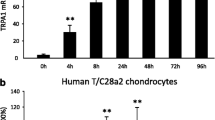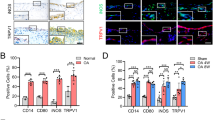Abstract
Transient receptor potential ankyrin 1 (TRPA1) is a membrane-associated cation channel, widely expressed in neuronal and non-neuronal cells. Recently, emerging evidences suggested the crucial role of TRPA1 in the disease progression of osteoarthritis (OA). Therefore, we aimed to investigate whether TRPA1 mediate lipopolysaccharide (LPS)-induced inflammatory responses in primary human OA fibroblast-like synoviocytes (OA-FLS). The expression of TRPA1 in LPS-treated OA-FLS was assessed by polymerase chain reaction (PCR) and western blot (WB), and the functionality of TRPA1 channel by Ca2+ influx measurements. Meanwhile, production of interleukin (IL)-1β, tumor necrosis factor (TNF)-α, IL-6, matrix metalloproteinase (MMP)-1, and MMP-3 in LPS-treated cells was measured by immunoassay. Histological observation after inhibition of TRPA1 was also performed in rats with LPS-induced inflammatory arthritis. After being induced by LPS, the gene and protein expression of TRPA1 was increased in the time-dependent or dose-dependent manner. Meanwhile, Ca2+ influx mediated by TRPA1 in human OA-FLS was also enhanced. In addition, pharmacological inhibition and gene silencing of TRPA1 downregulated the production of IL-1β, TNF-α, IL-6, MMP-1, and MMP-3 in LPS-treated FLS. Finally, synovial inflammation and cartilage degeneration were also reduced by the TRPA1 antagonist. We found the LPS caused the increased functional expression of TRPA1, the activation of which involved in LPS-reduced inflammatory responses in primary human OA-FLS, and the inhibition of TRPA1 produces protective effect in LPS-induced arthritis.





Similar content being viewed by others
References
Chen, J., S.K. Joshi, S. DiDomenico, R.J. Perner, J.P. Mikusa, and D.M. Gauvin. 2011. Selective blockade of TRPA1 channel attenuates pathological pain without altering noxious cold sensation or body temperature regulation. Pain 152: 1165–1172.
McNamara, C.R., J. Mandel-Brehm, and D.M. Bautista. 2007. TRPA1 mediates formalin-induced pain. Proceedings of the National Academy of Sciences of the United States of America 104: 13525–13530.
Story, G.M., A.M. Peier, A.J. Reeve, S.R. Eid, J. Mosbacher, and T.R. Hricik. 2003. ANKTM1, a TRP-like channel expressed in nociceptive neurons, is activated by cold temperatures. Cell 112: 819–829.
Nilius, B., G. Appendino, and G. Owsianik. 2012. The transient receptor potential channel TRPA1: From gene to pathophysiology. Pflügers Archiv 464: 425–458.
Atoyan, R., D. Shander, and N.V. Botchkareva. 2009. Non-neuronal expression of transient receptor potential type A1 (TRPA1) in human skin. The Journal of Investigative Dermatology 129: 2312–2315.
Hu, H., M. Bandell, M.J. Petrus, M.X. Zhu, and A. Patapoutian. 2009. Zinc activates damage sensing TRPA1 ion channels. Nature Chemical Biology 5: 183–190.
Earley, S., A.L. Gonzales, and R. Crnich. 2009. Endothelium-dependent cerebral artery dilation mediated by TRPA1 and Ca2+-activated K+ channels. Circulation Research 104: 987–994.
Nummenmaa, Elina, Mari Hämäläinen, and Lauri J. Moilanen. 2016. Transient receptor potential ankyrin 1 (TRPA1) is functionally expressed in primary human osteoarthritic chondrocytes. Arthritis Research & Therapy 18: 185.
Jordt, S.E., D.M. Bautista, H.H. Chuang, D.D. McKemy, P.M. Zygmunt, and E.D. Hogestatt. 2004. Mustard oils and cannabinoids excite sensory nerve fibres through the TRP channel ANKTM1. Nature 427: 260–265.
Bautista, D.M., P. Movahed, A. Hinman, H.E. Axelsson, O. Sterner, and E.D. Hogestatt. 2005. Pungent products from garlic activate the sensory ion channel TRPA1. Proceedings of the National Academy of Sciences of the United States of America 102: 12248–12252.
Trevisani, M., J. Siemens, S. Materazzi, D.M. Bautista, R. Nassini, and B. Campi. 2007. 4-Hydroxynonenal, an endogenous aldehyde, causes pain and neurogenic inflammation through activation of the irritant receptor TRPA1. Proceedings of the National Academy of Sciences of the United States of America 104: 13519–13524.
Sawada, Y., H. Hosokawa, K. Matsumura, and S. Kobayashi. 2008. Activation of transient receptor potential ankyrin 1 by hydrogen peroxide. The European Journal of Neuroscience 27: 1131–1142.
Zygmunt, P.M., and E.D. Högestätt. 2014. Trpa1. Handbook of Experimental Pharmacology 222: 583–630.
Jakobsson, P.J. 2010. Pain: How macrophages mediate inflammatory pain via ATP signaling. Nature Reviews Rheumatology 6: 679–681.
Korhonen, R., H. Kankaanranta, A. Lahti, M. Lahde, R.G. Knowles, and E. Moilanen. 2001. Bidirectional effects of the elevation of intracellular calcium on the expression of inducible nitric oxide synthase in J774 macrophages exposed to low and to high concentrations of endotoxin. The Biochemical Journal 354: 351–358.
Berridge, M.J., P. Lipp, and M.D. Bootman. 2000. The versatility and universality of calcium signalling. Nature Reviews. Molecular Cell Biology 1: 11–21.
Moilanen, L.J., M. Laavola, M. Kukkonen, R. Korhonen, T. Leppanen, and E.D. Hogestatt. 2012. TRPA1 contributes to the acute inflammatory response and mediates carrageenan-induced paw edema in the mouse. Scientific Reports 2: 380.
Caceres, A.I., M. Brackmann, M.D. Elia, B.F. Bessac, D. del Camino, and M. D’Amours. 2009. A sensory neuronal ion channel essential for airway inflammation and hyperreactivity in asthma. Proceedings of the National Academy of Sciences of the United States of America 106: 9099–9104.
Trevisan, G., C. Hoffmeister, M.F. Rossato, S.M. Oliveira, M.A. Silva, and R.P. Ineu. 2013. Transient receptor potential ankyrin 1 receptor stimulation by hydrogen peroxide is critical to trigger pain during monosodium urate-induced inflammation in rodents. Arthritis and Rheumatism 65: 2984–2995.
Moilanen, L.J., M. Hämäläinen, L. Lehtimäki, R.M. Nieminen, and E. Moilanen. 2015. Urate crystal induced inflammation and joint pain are reduced in transient receptor potential ankyrin 1 deficient mice-potential role for transient receptor potential ankyrin 1 in gout. PLoS One 10: e0117770.
Moilanen, L.J., M. Hämäläinen, E. Nummenmaa, P. Ilmarinen, K. Vuolteenaho, and R.M. Nieminen. 2015. Monosodium iodoacetate-induced inflammation and joint pain are reduced in TRPA1 deficient mice-potential role of TRPA1 in osteoarthritis. Osteoarthritis and Cartilage 23: 2017–2026.
Loeser, R.F., S.R. Goldring, and C.R. Scanzello. 2012. Osteoarthritis: A disease of the joint as an organ. Arthritis and Rheumatism 64: 1697–1707.
Mobasheri, A., M.P. Rayman, and O. Gualillo. 2017. The role of metabolism in the pathogenesis of osteoarthritis. Nature Reviews Rheumatology 13: 302–311.
Steenvoorden, M.M., Bank RA, H.K. Ronday, R.E. Toes, T.W. Huizinga, and J. DeGroot. 2007. Fibroblast-like synoviocyte-chondrocyte interaction in cartilage degradation. Clinical and Experimental Rheumatology 25: 239–245.
Fuchs, S., A. Skwara, M. Bloch, and B. Dankbar. 2004. Differential induction and regulation of matrix metalloproteinases in osteoarthritic tissue and fluid synovial fibroblasts. Osteoarthritis and Cartilage 12: 409–418.
Nair, A., V. Kanda, C. Bush-Joseph, N. Verma, S. Chubinskaya, and K. Mikecz. 2012. Synovial fluid from patients with early osteoarthritis modulates fibroblast-like synoviocyte responses to toll-like receptor 4 and toll-like receptor 2 ligands via soluble CD14. Arthritis and Rheumatism 64: 2268–2277.
Hatano, N., Y. Itoh, H. Suzuki, Y. Muraki, H. Hayashi, and K. Onozaki. 2012. Hypoxiainducible factor-1 alpha (HIF1 alpha) switches on transient receptor potential ankyrin repeat 1 (TRPA1) gene expression via a hypoxia response elementlike motif to modulate cytokine release. The Journal of Biological Chemistry 287: 31962–31972.
Kochukov, Mikhail Y., Terry A. McNearney, and Fu. Yibing. 2006. Thermosensitive TRP ion channels mediate cytosolic calcium response in human synoviocytes. American Journal of Physiology. Cell Physiology 2: C424–C432.
Runlin XING, Peimin WANG, Linrui ZHAO, Bo XU, Nongshan ZHANG, Xiaochen LI. 2017. Mechanism of TRPA1 and TRPV4 participating in mechanical hyperalgesia of rat experimental knee osteoarthritis. Arch Rheumatol 32. doi: 10.5606/ArchRheumatol.2017.6061 [in press].
Recommendations for the medical management of osteoarthritis of the hip and knee: 2000 update. American College of Rheumatology Subcommittee on Osteoarthritis Guidelines. Arthritis and Rheumatism 43: 1905–1915.
Abu-Ghefreh, A.A., and W. Masocha. 2010. Enhancement of antinociception by coadministration of minocycline and a non-steroidal anti-inflammatory drug indomethacin in naïve mice and murine models of LPS-induced thermal hyperalgesia and monoarthritis. BMC Musculoskeletal Disorders 11: 276.
Masocha, W., and S.S. Parvathy. 2009. Assessment of weight bearing changes and pharmacological antinociception in mice with LPS-induced monoarthritis using the Catwalk gait analysis system. Life Sciences 85: 462–469.
van der Sluijs, J.A., R.G. Geesink, A.J. van der Linden, S.K. Bulstra, R. Kuyer, and J. Drukker. 1992. The reliability of the Mankin score for osteoarthritis. Journal of Orthopaedic Research 10: 58–61.
Jaquemar, D., T. Schenker, and B. Trueb. 1999. An ankyrin-like protein with transmembrane domains is specifically lost after oncogenic transformation of human fibroblasts. The Journal of Biological Chemistry 274: 7325–7333.
Kapoor, M., J. Martel-Pelletier, D. Lajeunesse, J.P. Pelletier, and H. Fahmi. 2011. Role of proinflammatory cytokines in the pathophysiology of osteoarthritis. Nature Reviews Rheumatology 7: 33–42.
Jin, X.N., E.Z. Yan, H.M. Wang, H.J. Sui, Z. Liu, W. Gao, and Y. Jin. 2016. Hyperoside exerts anti-inflammatory and anti-arthritic effects in LPS-stimulated human fibroblast-like synoviocytes in vitro and in mice with collagen-induced arthritis. Acta Pharmacologica Sinica 37: 674–686.
Wu, R., L. Long, Q. Chen, X. Wu, J. Zhu, B. Zhou, and J. Cheng. 2017. Effects of Tim-3 silencing on the viability of fibroblast-like synoviocytes and lipopolysaccharide-induced inflammatory reactions. Experimental and Therapeutic Medicine 14: 2721–2727.
Huang, Z., and V.B. Kraus. 2016. Does lipopolysaccharide-mediated inflammation have a role in OA? Nature Reviews Rheumatology 12: 123–129.
Prandini, P., F. De Logu, C. Fusi, L. Provezza, R. Nassini, G. Montagner, S. Materazzi, S. Munari, E. Gilioli, V. Bezzerri, A. Finotti, I. Lampronti, A. Tamanini, M.C. Dechecchi, G. Lippi, C.M. Ribeiro, A. Rimessi, P. Pinton, R. Gambari, P. Geppetti, and G. Cabrini. 2016. Transient receptor potential ankyrin 1 channels modulate inflammatory response in respiratory cells from patients with cystic fibrosis. American Journal of Respiratory Cell and Molecular Biology 55: 645–656.
Bezzerri, V., M. Borgatti, A. Finotti, A. Tamanini, R. Gambari, and G. Cabrini. 2011. Mapping the transcriptional machinery of the il-8 gene in human bronchial epithelial cells. Journal of Immunology 187: 6069–6081.
Meseguer, V., Y.A. Alpizar, E. Luis, S. Tajada, B. Denlinger, O. Fajardo, J.A. Manenschijn, C. Fernandez-Pena, A. Talavera, T. Kichko, B. Navia, A. Sanchez, R. Senaris, P. Reeh, M.T. Perez-Garcia, J.R. Lopez-Lopez, T. Voets, C. Belmonte, K. Talavera, and F. Viana. 2014. TRPA1 channels mediate acute neurogenic inflammation and pain produced by bacterial endotoxins. Nature Communications 5: 3125.
Acknowledgements
The authors wish to express their gratitude to all staffs in the medical research center of first college of clinical medicine, the Nanjing University of Chinese Medicine, Nanjing, China.
Funding
This research was supported by the National Natural Science Foundation of China (81573993), the National Natural Science Foundation of China (81774334), the Natural Science Foundation of Jiangsu Province(BK20171513) and Natural Science Foundation of Jiangsu Province (BK20151598).
Author information
Authors and Affiliations
Contributions
SongJiang Yin and Peimin Wang conceived the study and drafted the manuscript. Li Zhang and Linrui Zhao designed and performed the animal experiments; Xiaochen Li and Yancheng Xiao performed cell experiments. All authors read and approved the final manuscript. All authors approved the final version and are accountable for all aspects of the manuscript.
Corresponding author
Ethics declarations
Ethics Approval and Consent to Participate
All animal protocols were approved (reference number: ACU170701) by the Animal Care and Use Committee of the Nanjing University of Chinese Medicine. All experiments were conducted in accordance with the National Institutes of Health Guidelines for the Care and Use of Laboratory Animals.
Synovial tissues in knee OA patients obtained from knee joint replacement surgery were removed with patients’ consent. The patients in this study met the American College of Rheumatology classification criteria for OA and the study was approved (reference number: 2015NL-068-02) by the Ethics Committee of Affiliated Hospital of Nanjing University of Chinese Medicine, Nanjing, China.
Consent for Publication
Data was de-identified, after collection, and therefore, there was no consent required from individual patients, according to the ethical approval.
Competing Interests
The authors declare that there is no conflict of interests.
Electronic supplementary material
Rights and permissions
About this article
Cite this article
Yin, S., Wang, P., Xing, R. et al. Transient Receptor Potential Ankyrin 1 (TRPA1) Mediates Lipopolysaccharide (LPS)-Induced Inflammatory Responses in Primary Human Osteoarthritic Fibroblast-Like Synoviocytes. Inflammation 41, 700–709 (2018). https://doi.org/10.1007/s10753-017-0724-0
Published:
Issue Date:
DOI: https://doi.org/10.1007/s10753-017-0724-0




